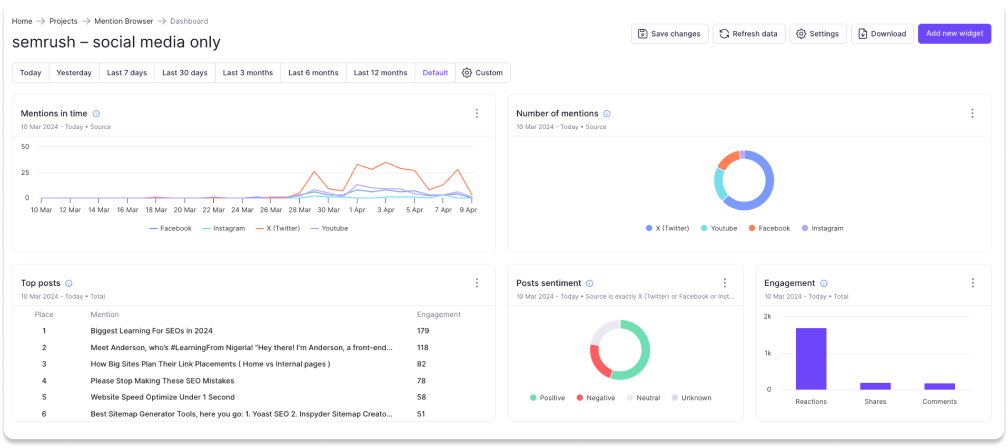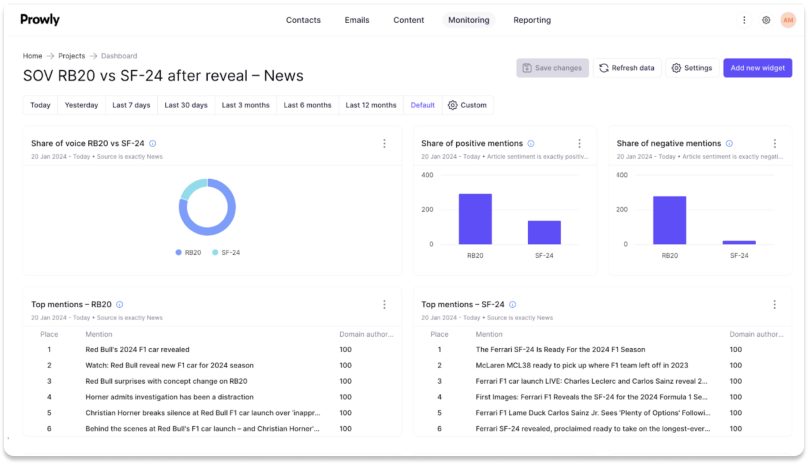Running social media campaigns without tracking results is like participating in a race without a leader board. Sure, you might have fun, but what's the actual point?
The problem with monitoring social media performance is that there is so much you can track that it's easy to do too little or too much.
Analyzing social media campaign effectiveness is easier than you might think. This is why we've prepared a guide on the most important social media metrics you should track across platforms. While this guide is made for PR professionals, anyone can use these metrics for their own social media analysis.
Try Prowly's media monitoring free for 7 days
Start tracking your brand and keywords for free (no credit card required) in Prowly.
- Comprehensive monitoring: Track the web and social media mentions.
- Transparent pricing: Plans start at $258/month
- All-in-one platform: Get everything you need in one tool for PR, incl. media database, outreach, reporting, and more
Why PR pros need to care about social media metrics
Social media platforms have become the new battlefront for public relations. With more than five billion people on social media, being present online is no longer optional.
The role of public relations on social media has evolved from simply pitching journalists to covering media outlets in real time, tracking journalist engagement, and handling reputation management. In short, social is a major part of PR in 2025.
The difference between social media for marketing and PR is that marketing is primarily preoccupied with building a brand and an audience and selling a product or service directly (and indirectly).
Meanwhile, PR aims to spread stories about the brand to relevant journalists, content creators, and influencers and amplify the brand's reach online.
The most important social media metrics for PR
The social media KPIs that PR teams use differ slightly from those used for marketing. Here's how to measure social media performance for public relations and which metrics to use:
Engagement (beyond vanity metrics)
💡 Why it matters for PR: Unlike marketing, PR doesn't just chase likes and shares. The end goal is to build meaningful connections with the right people in your target audience and earn media attention for your brand.
Instead of going after the total count of likes, shares, and comments, PR teams should focus on where they are coming from.
For example, a high-profile journalist in your industry retweeting something you shared would be a big win for public relations. Meanwhile, 20 retweets from customers would be great for marketing but not so much for PR.
Use dedicated social media measurement tools that give precise analytics regarding your target audience. For example, Prowly lets you filter the media mentions of your brand based on specific audiences so you're only tracking metrics from relevant sources.

Also, track your engagement rate by dividing your total engagement (likes, comments, and shares) by your number of followers. Multiply by 100 and you'll get a percentage value you can use as a benchmark for future social media measures.
Brand mentions & sentiment analysis
💡 Why it matters for PR: Brand mentions happen when someone uses your brand's name on social media by tagging you or simply writing it out. Understanding brand mentions means finding out how people perceive your brand and it lets you proactively manage your reputation, resolve crises, and fine-tune your messaging.
The volume of mentions: How many times your brand gets mentioned across social media platforms. Typically, the more the better. However, you need to look beyond the numbers.

The context of mentions: In which way is someone mentioning you and what is it about? Did you just launch a new product that is making waves? Is a press release getting significant media coverage? Is there a full-on crisis brewing?
The sentiment of the mentions: When someone mentions your brand, it can be in a positive, neutral or negative sentiment. Doing this analysis manually is a chore, especially with many mentions rolling in. This is where sentiment analysis in tools, such as Prowly, come in handy.

Earned vs. owned social media impact
💡 Why it matters for PR: Public relations experts must differentiate between the content they control and the content that others create about them which spreads through social media organically.
To measure the organic performance of your PR-driven content, use one of the following metrics:
Social media reach: The number of unique users that have seen your content. Keeping your eye on this metric shows you how well content spreads organically, as opposed to paid methods.
Virality rate: When you divide the number of shares by the number of impressions and multiply the number by 100, you get this KPI. The higher the virality rate, the more people there are who share your content, which signals that your earned media efforts are paying off.
Organic vs. paid reach: As the name suggests, this is the ratio of your content's reach with and without promotion. If your content is making an impact without the need to boost it with cash, you're on a good track.
👉 Tip: Read this full guide on social media reputation to get a complete picture of your PR strategy.
Journalist & influencer interactions
💡 Why it matters for PR: Tracking who interacts with your content is more important than getting lots of reach from an audience that is irrelevant for your business or client.
Tracking this isn't too difficult, either.
Shares and mentions by journalists: Of the total mentions and shares, single out the portion that come from journalists. If they share your press releases, corporate statements, reports, or similar content, your PR efforts are paying off.
Influencer and thought leader engagement: If relevant experts are engaging with your brand's content, your PR storytelling is working.
Response rates to media inquiries: How quickly your PR team replies to journalists and handles crises on social media.
How to use social media metrics to improve PR strategies
Now that you've collected the right set of social media metrics, you can use them to guide your business or brand's PR strategies.
First, use this information to identify media trends and journalists' interests from social data. Aside from tracking the performance of your own content, you can use social media tracking and PR tools to find what journalists read and engage with.
The next point of action is to be prepared for social media crises. Thanks to media monitoring tools, you can detect PR crises early on. As soon as a monitoring tool detects a spike in mentions (especially those with negative sentiment), you can get notified so you can jump in. The same applies to your competitors' brands.
Lastly, you can use analytics to fine-tune your messaging. You can see if certain kinds of messaging strategies do not resonate with journalists or your target audience, allowing you to adjust on the fly.
P.S. Check out this guide on social media crisis management to fine-tune your strategy with a few practical tips.
PR tools vs. social media tools: why PR pros need both
To track all these metrics, you could use PR tools or social media management tools... Or both. Here's how they fare against each other.
| Feature | Social Media Management Platforms | PR Software |
| Primary focus | Managing and optimizing brand presence on social media platforms. | Building and maintaining relationships with journalists, media outlets, and public stakeholders. |
| Media outreach | Typically lacks built-in journalist databases or press release distribution. | Provides media contact databases, press release distribution, and pitching tools. |
| Crisis management | Monitors brand reputation via social listening but lacks direct media crisis response tools. | Helps manage public perception, craft crisis communication strategies, and reach media quickly. |
| Owned vs. earned Media | Focuses on owned media (social posts, paid ads, influencer collaborations). | Focuses on earned media (press coverage, media mentions, reputation management). |
| Target users | Social media marketers, content teams, digital advertisers. | PR teams, corporate communication professionals, brand reputation managers. |
So, which one do you need?
- A social media management platform is the better choice if you aim to manage daily social content, run ad campaigns, and engage with followers, with all the data tied into a social media report.
- PR software is more suitable if you need to secure media coverage, manage press relationships, and handle crisis communication.
- Many brands use both in tandem for a comprehensive digital and media strategy.
The great news is that you don't have to choose. With Prowly, you get all the features you need to manage your online presence in one app.

💡 Tip: Read this full guide on social media reputation to get a complete picture of your PR strategy.
Conclusion
There is no PR strategy in 2025 without using social media. The problem is that social media is uncharted territory for many PR professionals, requiring a lot of time and effort. However, you can manage your social media and PR presence with the right tools.
Try Prowly today for free to see how we can help you monitor, measure, and improve the social media presence of your business or clients.

